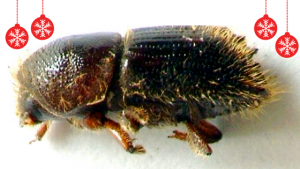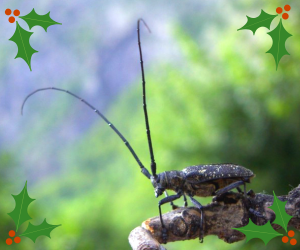For many, December means celebrating Christmas and a central part of that is a Christmas tree. Evergreen trees have been used in celebration for centuries. The ancient Egyptians, Chinese, and Hebrews used evergreen trees, wreaths, and garlands to symbolize eternal life. Pagans worshiped trees, and Romans used evergreen wreaths during the festival of Saturnalia.
The trees commonly used as Christmas decorations come from the genus Picea which is made up of around 35 species of coniferous evergreen trees in the family Picaceae. Popular Christmas tree species include Balsam Fir, Douglas Fir, and Norway Spruce.
The modern-day Christmas tree is thought to have started in 16th century Germany when Christians brought decorated trees into their homes. The Christmas traditions we know today were shaped by the Victorians, when the first Christmas tree was brought from Germany to the British royal household by Prince Albert in the 1840s. These days, around 7 million real trees are sold each year in the UK, and as many as 30 million in the USA.
But with real trees come real creatures…
Luckily, homes aren’t exactly an appropriate habitat for insects that inhabit coniferous forests and if any sneak in over the festive season, they won’t be moving in for good. With a lack of food and adequate humidity to survive, most Christmas tree insects will die soon after moving indoors. They prefer shaded and moist conditions, not a cosy Christmas fire under the glow of fairy lights.
If you do spot signs of aphids or other small insects, it is much safer to simply clean up any dead insects you find. Whatever you do, do not spray any aerosol pesticides on your Christmas tree – they are highly flammable!
Top tip: before bringing your tree indoors, give it a vigorous shake to dislodge any creatures that might be clinging on. This should be enough to ensure you don’t invite any of our 12 pests of Christmas (trees) into the house.
1. Green Spruce Aphid
Elatobium abietinum

Native to Europe, the green spruce aphid is a serious invasive pest in North America. Defoliation of trees due to this pest has the potential to alter forest succession and species composition, and even impact other flora and fauna. Their highly dispersive nature during the flight period means that once established, these aphids will eventually spread throughout the forested area to the limits of their climatic tolerances.
2. Spruce beetle
Dendroctonus rufipennis

This beetle is considered to be one of the most destructive insect pests of spruce forests in North America. Historically it has caused huge damage and during an outbreak in Alaska in the 1990s destroyed around 30 million trees per year at its peak. Adult spruce beetles are quite strong fliers, flying at least 2-3km in search of new hosts, plus their small size means they can reach even further on wind and air currents.
3. Silver fir adelges
Dreyfusia nordmannianae

In the 1840s this aphid was introduced to central Europe and ever since has become a well-established invasive pest. Its favoured tree is the Nordmann fir, which is the main tree species for Christmas tree production in northern Europe. Denmark is the leading producer of Nordmann fir Christmas trees with up to 10 million exported annually and the cost of spraying the trees each year in order to tackle this pest is significant.
4. Eight-toothed bark beetle
Ips typographus

A species of beetle in the weevil subfamily, the eight-toothed bark beetle is a serious and destructive pest of spruce trees. It is a significant quarantine pest and has already been intercepted at British ports. The beetles are able to fly over long distances or could be transported in wood packaging or bark.
5. Brown spot needle blight
Mycosphaerella dearnessii

This fungus causes serious damage to pine trees, killing foliage and stunting growth. In Christmas tree plantations, an attack of brown-spot needle blight could result in huge economic losses because of needle drop, making the trees unsaleable. It has a wide host and habitat range because potentially all pine species are hosts.
6. White pine sawfly
Diprion similis

Native to central and northern Europe, Russian Siberia, and China, this pest was first detected in Connecticut in 1914 and has since spread to much of the eastern United States and Canada; wherever its favourite food, Pinus strobus is found. The females are poor fliers, and so most of its expansion in North America has been the result of infested nursery stock, trees, and foliage.
7. Western yellowjacket
Vespula pensylvanica

This wasp is widely distributed and native to all US states west of the Rocky Mountains. It has made this list because its only invasive record is in Hawaii, almost certainly due to the Christmas tree trade. It was first reported on Kaua‘i Island in 1919 and periodic outbreaks continue today. Single queens that overwinter in the foliage can found new colonies in their non-native range.
8. Great spruce bark beetle
Dendroctonus micans

This beetle is believed to have originated in the conifer forests of Asia and has steadily spread westward over the past 100 years, likely due to the increased trade in unprocessed logs. The great spruce bark beetle burrows into the bark of spruce trees and lays eggs which develop into larvae that feed on the woody layers under the bark.
9. Needle rust of fir
Chrysomyxa abietis

This is a microcyclic rust fungus; an obligate parasite completing its life cycle on spruce trees. Now absent in North America, it was once introduced without establishment in 1907 on nursery stock of Picea abies from Denmark. Small amounts of infection may be overlooked and the trade of Christmas trees poses the biggest risk for accidental introduction.
10. European pine sawfly
Neodiprion sertifer

This invasive pest was first recorded in New Jersey in 1925 and Ontario in 1939. After this accidental introduction from Europe it rapidly dispersed throughout north east America and south east Canada. The larvae feast on pine needles, stunting tree growth, although rarely enough to kill the tree.
11. Lesser spruce shoot beetle
Hylurgops palliatus

Native across Europe and Asia, this beetle is invasive in the USA in New York, Ohio, and Pennsylvania. It is one of the ten most intercepted pests in the US. These robust beetles usually attack dead or dying trees by ingesting the lower part of the stems with the thick bark. Due to this, they are most likely to spread in the transport of infested bark or stems.
12. Small white-marmorated longicorn
Monochamus sutor

A species of beetle first described by Carl Linnaeus in 1758, the small white-marmorated longicorn occurs throughout much of Europe and Asia, spanning from the Pacific to Atlantic Oceans. Most longhorned beetles are considered secondary forest pests as they usually colonize woody plants already weakened by other factors. However, those in the Monochamus genus have become a cause for more concern because several species have been described as vectors of plant diseases.
Although tree pests might be a small nuisance in your home over the holiday season, this year saw many Christmas tree farmers across Europe lose their crop due to soaring summer temperatures. How will the Christmas tree tradition stand up to the challenge of climate change?
Useful links
3 Comments
Leave a Reply
Related News & Blogs
Jumping worms unearth problems for forest ecosystems
Adult Amynthas agrestis (crazy worm) ©Tom Potterfield (2011)/via Flickr The Asian jumping worm (Amynthas agrestis), also known as the crazy worm, is a litter dwelling earthworm which can harm forests and biodiversity by changing the soil structure and…
2 December 2022





Great blog. Interesting, entertaining and very informative.
Reblogged this on The CABI Blog.
Ixodes scapularis, the deer or black-legged tick [BLT] responsible for Lyme disease has infrequently been carried indoors on Christmas trees. BLTs prefer 82% humidity so they won’t last too long indoors.